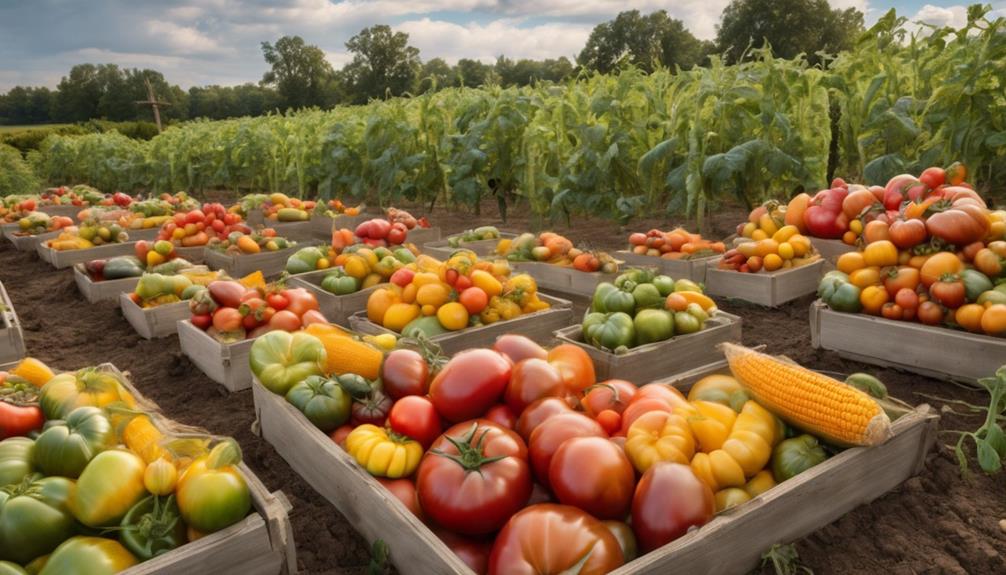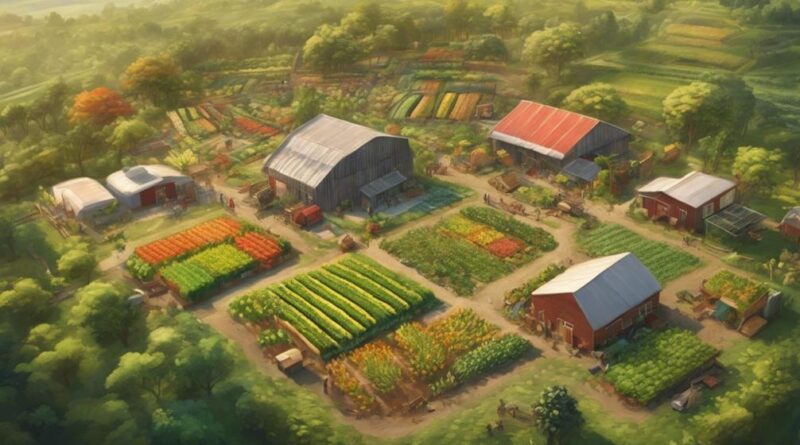Eco-Farming: Preserving Biodiversity Through Natural Agriculture
Have you ever wondered how eco-farming practices can truly impact biodiversity on a global scale?
The intricate dance between natural agriculture and the preservation of diverse ecosystems holds a key to ensuring a sustainable future for our planet.
By exploring the interconnected web of relationships between plants, animals, and the environment, a deeper understanding emerges.
Stay with us to unravel the layers of how eco-farming can not only sustain but actively enrich the rich tapestry of life around us.
Benefits of Organic Farming
Organic farming offers numerous benefits for both the environment and human health. By implementing sustainable practices, organic farmers prioritize environmental conservation while producing healthy, nutrient-rich soil that yields nutritious produce. Unlike conventional farming methods that rely on synthetic pesticides and fertilizers, organic farming promotes a more balanced ecosystem that benefits all living organisms.
The sustainable practices in organic farming include crop rotation, composting, and natural pest control methods. These techniques not only help maintain soil fertility but also reduce the reliance on chemical inputs that can harm the environment. Through these methods, organic farmers work in harmony with nature to ensure the long-term health of the soil and surrounding ecosystems.
One of the key advantages of organic farming is the production of healthy produce. By avoiding synthetic chemicals, organic fruits and vegetables are free from harmful residues, making them safer for consumption. Additionally, studies have shown that organic produce tends to be higher in essential nutrients, such as vitamins, minerals, and antioxidants, due to the nutrient-rich soil in which they're grown.
Enhancing Soil Health
To further improve agricultural practices and promote sustainable farming, prioritizing soil health is essential. Soil health is the foundation of successful eco-farming, and enhancing it through practices like soil regeneration and nutrient cycling can have numerous benefits. Soil regeneration involves restoring the soil's vitality by increasing organic matter content, promoting microbial activity, and improving soil structure. This process helps to create a healthy environment for plants to grow, leading to higher yields and better crop quality.
Nutrient cycling is another crucial aspect of enhancing soil health in eco-farming. By cycling nutrients back into the soil through methods like cover cropping, crop rotation, and composting, farmers can maintain the fertility of the soil without relying heavily on synthetic fertilizers. This not only reduces the environmental impact of farming but also ensures the long-term productivity of the land.
Incorporating these practices into your farming methods can lead to improved soil health, increased resilience to pests and diseases, and better water retention. Healthy soils also support a diverse range of beneficial organisms, contributing to overall ecosystem health. By prioritizing soil health through soil regeneration and nutrient cycling, you can't only preserve biodiversity but also create a sustainable farming system that will benefit both the environment and future generations.
Promoting Pollinator Habitats
Enhance your farm's biodiversity by creating vibrant habitats for pollinators. One effective way to achieve this is by incorporating wildflower meadows into your farming landscape. Wildflower meadows provide a diverse array of nectar and pollen sources for pollinators, attracting various species like bees, butterflies, and birds. By sowing native wildflowers, you can create a colorful and dynamic ecosystem that supports pollinator populations throughout the seasons.
In addition to wildflower meadows, consider planting bee-friendly crops on your farm. These crops, such as sunflowers, lavender, and clover, offer rich sources of food for bees and other pollinators. By including these crops in your agricultural practices, you not only provide essential nutrition for pollinators but also increase crop yields through enhanced pollination services.
Creating pollinator habitats goes beyond just planting flowers; it also involves minimizing pesticide use and providing nesting sites for bees and other insects. Avoiding the use of harmful chemicals and incorporating features like bee hotels or nesting boxes can further support pollinator populations on your farm.
Minimizing Chemical Runoff
Consider the impact of agricultural practices on the environment by focusing on minimizing chemical runoff from your farm. Reducing pollution through sustainable practices is crucial for preserving biodiversity.
One effective way to minimize chemical runoff is by implementing conservation tillage techniques. By disturbing the soil less, you can reduce erosion and the amount of chemicals that wash off into water sources. Additionally, using cover crops can help prevent runoff by absorbing excess nutrients and chemicals, thus keeping them from leaching into the soil.
Another sustainable practice to consider is precision farming, where you apply fertilizers and pesticides more precisely to avoid excess runoff. By using technology such as GPS-guided equipment, you can target specific areas that require treatment, minimizing the overall use of chemicals. Implementing buffer zones along water bodies can also help trap sediments and filter out chemicals before they reach streams or rivers.
It is essential to regularly monitor water sources near your farm for any signs of chemical contamination. By testing the water quality, you can ensure that your efforts to minimize chemical runoff are effective. Remember, every small step you take towards reducing pollution can have a significant impact on preserving biodiversity and the environment for future generations.
Diverse Crop Rotation Practices
How can crop rotation practices contribute to maintaining soil health and biodiversity on your farm?
Crop rotation is a fundamental technique that can significantly benefit your farm's soil fertility and pest management. By rotating different crops in a planned sequence across your fields, you can help improve soil structure, increase nutrient availability, and reduce the buildup of pests and diseases.
Diverse crop rotation practices play a vital role in enhancing soil fertility. Planting a variety of crops helps replenish soil nutrients as different plants have varying nutrient requirements. For example, legumes like beans and peas can fix nitrogen into the soil, benefiting subsequent crops that require nitrogen for growth. This natural process reduces the reliance on synthetic fertilizers, promoting healthier soil ecosystems in the long run.
Furthermore, crop rotation aids in pest management by disrupting the life cycles of pests and diseases. When the same crop is planted repeatedly in the same area, pests that target that specific crop can build up in the soil, leading to infestations. Rotating crops breaks this cycle, making it harder for pests to establish themselves and reducing the need for chemical pesticides.
Incorporating diverse crop rotation practices into your farming methods can improve soil health, reduce pest pressure, and promote biodiversity on your farm. By implementing these techniques, you can create a more sustainable and resilient agricultural system that benefits both the environment and your crops.
Protecting Endangered Species
To safeguard biodiversity and promote ecological balance on your farm, prioritize the protection of endangered species through proactive conservation measures. By focusing on environmental stewardship and species protection, you play a crucial role in preserving the delicate balance of nature. Implementing habitat restoration and conservation initiatives tailored to the needs of endangered species can make a significant impact on their survival.
Creating safe havens for endangered species within your farm can be achieved by preserving and restoring their natural habitats. By identifying key areas where these species reside, you can implement habitat restoration projects to provide them with the necessary resources for survival. This proactive approach not only benefits the endangered species but also contributes to the overall health of the ecosystem.
Engaging in conservation initiatives such as monitoring populations, controlling invasive species, and minimizing human disturbances are essential practices in protecting endangered species. Your commitment to these efforts demonstrates your dedication to preserving biodiversity and ensuring a sustainable environment for future generations.
Preserving Genetic Diversity

Preserving genetic diversity is another critical aspect of eco-farming that complements the protection of endangered species, contributing to the resilience and adaptability of ecosystems. When you engage in seed saving and genetic preservation practices, you actively participate in safeguarding the variety of genes within plant and animal populations, ensuring their survival and ability to thrive in changing environments.
Here are four key reasons why preserving genetic diversity is essential in eco-farming:
- Resilience: By conserving a wide range of genetic traits, you enhance the resilience of crops and livestock against diseases, pests, and environmental stresses. This diversity acts as a natural insurance policy, helping agricultural systems withstand unforeseen challenges.
- Adaptability: Genetic diversity provides the foundation for adaptation. Through the selection and propagation of diverse genetic material, you support the development of new varieties better suited to changing climate conditions and evolving agricultural practices.
- Cultural Heritage: Seed saving practices not only preserve genetic diversity but also protect traditional knowledge and cultural heritage associated with farming. By saving and sharing seeds, you uphold centuries-old practices and maintain a connection to the land.
- Sustainability: Genetic preservation is integral to sustainable agriculture. By conserving diverse genetic resources, you reduce the reliance on monocultures and promote long-term agricultural sustainability through natural methods.
Supporting Wildlife Habitats
Supporting wildlife habitats significantly enhances biodiversity conservation efforts in eco-farming practices. Habitat restoration plays a crucial role in creating sustainable ecosystems that promote species diversity and ecosystem balance. By restoring and protecting natural habitats within and around eco-farms, you provide essential resources for a variety of wildlife species to thrive.
Wildlife corridors are vital in connecting fragmented habitats, allowing for the safe movement of animals between different areas. When eco-farms incorporate wildlife corridors into their design, you help preserve biodiversity by preventing isolation of species populations. This interconnectedness supports genetic flow and promotes healthier ecosystems.
Species diversity is key to maintaining a balanced ecosystem. By supporting wildlife habitats on eco-farms, you encourage the presence of various species, each playing a unique role in the environment. From pollinators like bees and butterflies to predators that control pest populations, every species contributes to the overall health and resilience of the ecosystem.
Ecosystem balance is achieved through the intricate interactions between different species. By supporting wildlife habitats through habitat restoration efforts, you foster a harmonious environment where each organism has a place and function. This balance results in increased ecosystem stability and resilience to external pressures, ultimately supporting the long-term sustainability of eco-farming practices.
Frequently Asked Questions
Can Eco-Farming Practices Help Combat Climate Change?
Yes, eco-farming practices can help combat climate change.
Carbon sequestration in soil through agroforestry techniques helps reduce greenhouse gas emissions.
Improving soil health and promoting biodiversity enhances climate resilience.
How Does Eco-Farming Contribute to Food Security?
To understand how eco-farming boosts food security, think about its role in promoting resilience and ensuring sustainability.
By using natural methods, eco-farming maintains soil health, conserves water, and protects biodiversity. This diverse ecosystem can withstand pests, diseases, and extreme weather events better than conventional farming.
Additionally, eco-farming supports local communities, reduces reliance on external resources, and provides a steady supply of nutritious food, contributing to long-term food security.
What Role Does Eco-Farming Play in Reducing Water Pollution?
When you practice eco-farming, you help reduce water pollution by promoting water conservation. Sustainable agriculture techniques like using natural fertilizers improve soil health, preventing harmful runoff into water sources.
Are There Any Specific Challenges Faced by Eco-Farmers?
Facing challenges, eco-farmers navigate issues like pests, soil fertility, and market access.
Solutions involve implementing natural pest control methods, enhancing soil health through composting, and creating direct sales channels.
How Can Consumers Support Eco-Farming Initiatives in Their Local Communities?
To support eco-farming in your community, engage with local farmers markets, ask about their sustainable practices, and choose to buy organic produce.
By actively participating and showing interest in eco-farming initiatives, you help create a demand for environmentally friendly agriculture. Community engagement plays a crucial role in promoting sustainable farming methods and preserving biodiversity.
Your choices as a consumer can make a positive impact on the environment and local ecosystem.
Conclusion
In conclusion, eco-farming is a sustainable approach to agriculture that helps preserve biodiversity through natural practices. By promoting healthy soil, providing habitats for pollinators, minimizing chemical runoff, and supporting diverse crop rotation, eco-farming plays a crucial role in protecting endangered species, preserving genetic diversity, and maintaining wildlife habitats.
Embracing eco-friendly farming methods isn't only beneficial for the environment, but also for the future of our planet.
